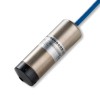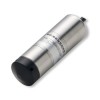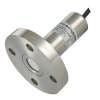Submersible sensors and instruments specifically designed for continuous immersion in high-temperature liquids up to 125°C (257°F). These specialized devices utilize materials and technologies that ensure reliable performance in demanding applications such as heated fuel tanks, food processing, and heated water tanks.
 LMK458 Marine Approved Hydrostatic Level Transmitter - Marine approved level transmitter with 4-20mA output for measuring level of contents inside ship ballast, fuel, liquid cargo or wastewater tanks
LMK458 Marine Approved Hydrostatic Level Transmitter - Marine approved level transmitter with 4-20mA output for measuring level of contents inside ship ballast, fuel, liquid cargo or wastewater tanks LMK382 Low Range IP68 Waste Water Level Transmitter - Submersible Low Range waste water level transmitter with intrinsically safe option for monitoring the level of sewage and effluent in water treatment plants.
LMK382 Low Range IP68 Waste Water Level Transmitter - Submersible Low Range waste water level transmitter with intrinsically safe option for monitoring the level of sewage and effluent in water treatment plants. LMK457 Marine Approved Level Transmitter - Marine approved level transmitter with 4-20mA current loop output for shipbuilding with optional all CuNiFe construction for sea-water compatibility in ranges from 0.4 mH2O to 250mH2O gauge.
LMK457 Marine Approved Level Transmitter - Marine approved level transmitter with 4-20mA current loop output for shipbuilding with optional all CuNiFe construction for sea-water compatibility in ranges from 0.4 mH2O to 250mH2O gauge.
- 3m range 4-20mA output submersible hot water tank level sensor
- 6m range 4-20mA submersible animal feed tank level and PT100 sensor
- Dairy wash water tank submersible level sensor for temperature up to 100C and 2m high tank
- High temperature mini sewage tank level sensor
Find out more about High Temperature Resistant Submersible Sensors and Instruments to determine which product options and capabilities will best meet your application requirements.
Submersible sensors and instruments deployed in high-temperature liquids face unique challenges:
- Material Degradation: Many common materials used in sensor construction, including plastics and adhesives, can degrade rapidly at elevated temperatures. This can lead to sensor failure and inaccurate readings.
- Electronics Reliability: Electronic components are highly susceptible to heat. Continuous operation at high temperatures can significantly reduce their lifespan and reliability.
- Cable Integrity: Standard cable insulation can soften, melt, or become brittle in hot liquids, compromising signal transmission and potentially leading to short circuits.
To ensure reliable operation in high-temperature liquids, specialized design and construction are essential:
- High-Temperature Materials: Sensor housings, probes, and wetted parts are constructed from materials like stainless steel, titanium, or high-temperature polymers that can withstand prolonged exposure to hot liquids without degradation.
- Specialized Electronics: Heat-Resistant Electronics: The internal electronics, including PCBs and sensors, are designed to operate reliably at elevated temperatures. This may involve using components with extended temperature ratings, specialized potting compounds, and thermal management techniques.
- High-Temperature Cables: Cables are typically constructed with high-temperature tolerant materials like TPE to maintain signal integrity and prevent damage in hot environments.
Applications
- Heated Fuel Tanks: Accurate level and temperature monitoring in fuel tanks ensures efficient operation and prevents safety hazards.
- Food Processing: Submersible sensors play a vital role in maintaining precise temperatures during cooking, sterilization, and cleaning processes, ensuring food safety and quality.
- Heated Water Tanks: Monitoring temperature and level in hot water tanks is crucial for optimal performance and energy efficiency in industrial and commercial settings.
- Industrial Processes: High-temperature submersible sensors are used in various industrial processes involving hot liquids, such as chemical manufacturing, oil and gas production, and power generation.
